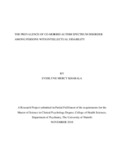| dc.contributor.author | Khabala, Everlyne M | |
| dc.date.accessioned | 2019-01-15T09:48:38Z | |
| dc.date.available | 2019-01-15T09:48:38Z | |
| dc.date.issued | 2018 | |
| dc.identifier.uri | http://hdl.handle.net/11295/104730 | |
| dc.description.abstract | The simultaneous presence of one or more additional disorders with the initially identified illness in the same person has been a topic receiving considerable attention in the study of mental disorders in children that are diagnosed during childhood. Autism spectrum disorders (ASDs) and intellectual disability (ID) manifest together at significant higher rates. In a similar way, the seriousness of one of these two disorders appears to have effects on the other disorder. ASD are a group of disorders that are typically first diagnosed in childhood. These disorders are characterized by a set of three impairments that often require early detection, identification and effective evidence based interventions in order to increase the likelihood of assisting these children reach their full potential throughout their lifespan and having improved long term outcomes. The study will result in increased knowledge and awareness of ASD and associated comorbidity with intellectual disability.
Objectives: The study aimed at identifying the prevalence of Autism Spectrum Disorder as co-morbid disorders in persons with Intellectual Disability in special needs schools in a rural Kenyan setting.
Method: The study was a cross-sectional descriptive design study using quantitative data collection method. It used primary data of 163 pupils categorized as Mentally Handicapped who attended Nangina and Lwanya special schools. Assessment of Autism Spectrum Disorder was by screening using the researcher designed socio-demographic questionnaire and the APA_DSM5_Clinician-Rated Severity of Autism Spectrum and Social Communication Disorders scale.
Results: 30 out of a total of 115 respondents in the age group of 6-28 were diagnosed as cases of ASD yielding a prevalence of 26.1% 95% C.I (18.3-34.8). Majority of these 30 diagnosed of comorbid ASD with ID (28.6%; 16/56) were male and (23.7%; 14/59) were female a male: female ratio of 1.14: 1. Respondents aged 6-8 (15.4%), 9-12 (31.6%), 13-17 (28.6%) and 18-28 (25.0%) were identified as cases of comorbid ASD with ID. A higher proportion was observed in respondents age 9-12 (31.6%).
Conclusion: Results suggest that intellectual disability and autism spectrum disorders commonly coexist. Lack of awareness and similar clinical manifestations lead to under diagnosis of autism spectrum disorder.
xi
These findings stress the importance of identifying persons with autism spectrum disorders at the earliest age so that early interventions can be made and the outcome may be more successful for such persons. | en_US |
| dc.language.iso | en | en_US |
| dc.publisher | University of Nairobi | en_US |
| dc.rights | Attribution-NonCommercial-NoDerivs 3.0 United States | * |
| dc.rights.uri | http://creativecommons.org/licenses/by-nc-nd/3.0/us/ | * |
| dc.subject | Co-Morbid Autism Spectrum Disorder | en_US |
| dc.title | The Prevalence Of Co-Morbid Autism Spectrum Disorder Among Persons With Intellectual Disability | en_US |
| dc.type | Thesis | en_US |



